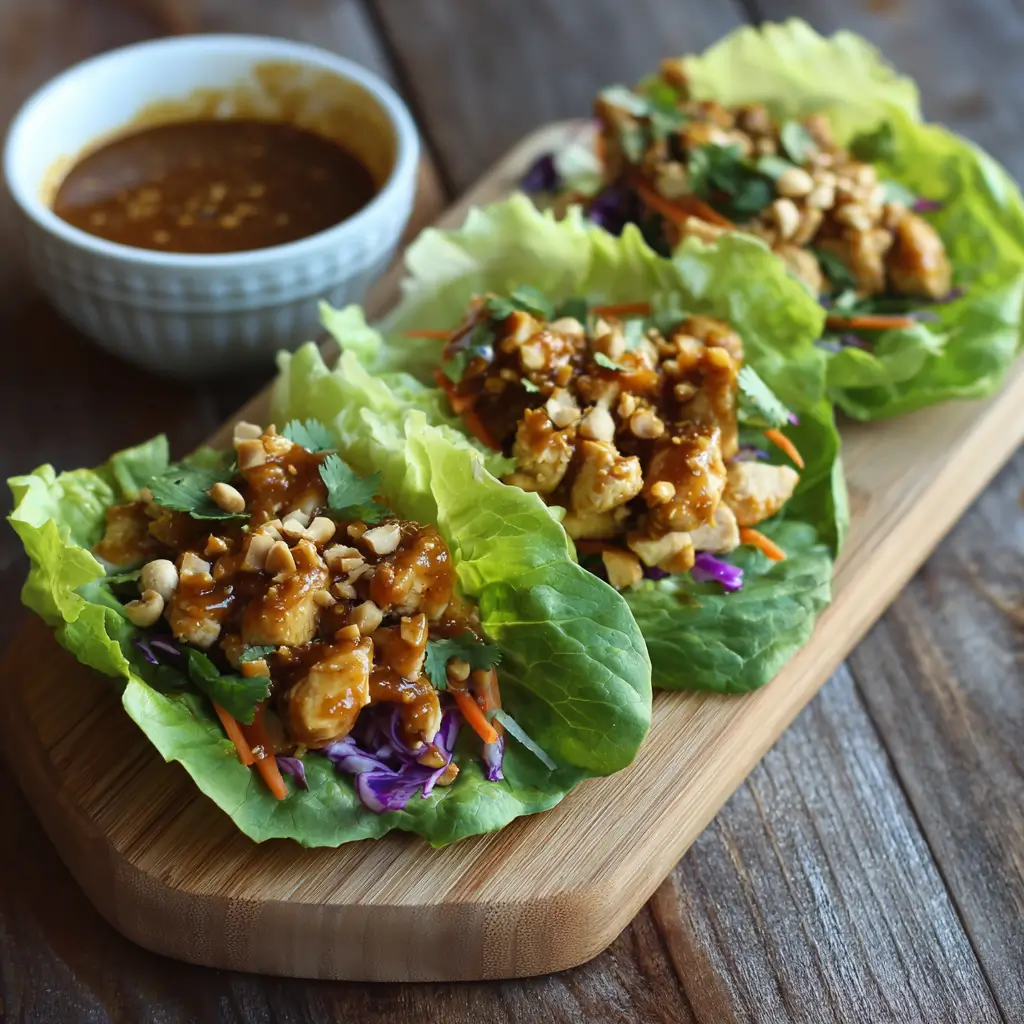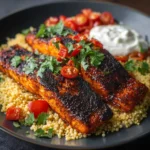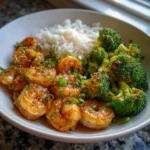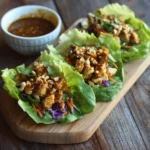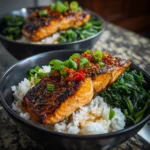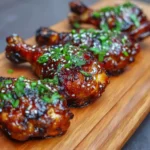Thai Peanut Chicken Lettuce Wraps are a vibrant, healthy, and flavorful dish that brings the bold tastes of Southeast Asia into your kitchen. Perfect for a light lunch, dinner, or appetizer, these wraps combine tender chicken, a rich peanut sauce, fresh vegetables, and crisp lettuce cups for a satisfying bite with every mouthful. Packed with protein, fiber, and aromatic herbs, this recipe is not only delicious but also easy to customize based on dietary preferences. Whether you’re following a low-carb, gluten-free, or clean-eating lifestyle, these Thai-inspired wraps will quickly become a staple in your weekly meal rotation.
The History
Thai cuisine has long been celebrated for its balance of sweet, sour, salty, spicy, and umami flavors. While traditional Thai meals often center around rice or noodles, the concept of using fresh vegetables as edible vessels—such as lettuce wraps—is rooted in both Thai and broader Southeast Asian culinary traditions. Dishes like miang kham, which involve wrapping small bites of food in betel leaves, demonstrate the region’s love for handheld, customizable meals. The fusion of Thai flavors with Western-style lettuce wraps gained popularity in the late 20th century, particularly in health-conscious and restaurant-driven food movements. Thai Peanut Chicken Lettuce Wraps emerged as a modern adaptation, blending authentic Thai ingredients like lemongrass, fish sauce, and peanut butter with accessible proteins like ground chicken and crisp romaine or butter lettuce. Today, they’re a favorite among home cooks and foodies alike for their ease, freshness, and explosion of flavor in every bite.
Ingredients Breakdown
The magic of Thai Peanut Chicken Lettuce Wraps lies in the harmony between savory, sweet, tangy, and nutty elements. Each ingredient plays a crucial role in building layers of flavor and texture:
- Ground Chicken: Lean ground chicken is ideal for absorbing the bold sauce while remaining tender and moist. You can substitute with turkey, tofu, or shrimp for variation.
- Lettuce Leaves: Butter lettuce, romaine hearts, or iceberg provide sturdy yet delicate cups that hold the filling without overpowering the taste.
- Peanut Butter: Natural, unsweetened peanut butter forms the base of the sauce, offering richness and creaminess. Almond butter or sunflower seed butter work well for allergies.
- Fish Sauce: A quintessential Thai ingredient, fish sauce adds depth and umami. Use soy sauce or tamari (gluten-free) as a vegetarian alternative.
- Lime Juice: Freshly squeezed lime juice brightens the dish and balances the richness of the peanut butter.
- Soy Sauce or Tamari: Adds saltiness and enhances the overall savoriness. Low-sodium versions help control salt levels.
- Coconut Aminos: A soy-free, slightly sweeter alternative to soy sauce, popular in paleo and allergen-friendly diets.
- Rice Vinegar: Contributes mild acidity and helps emulsify the sauce.
- Sesame Oil: Toasted sesame oil imparts a nutty aroma and depth; use sparingly due to its strong flavor.
- Garlic and Ginger: Freshly minced garlic and grated ginger bring pungency and warmth, essential for authentic Thai profiles.
- Red Pepper Flakes or Sriracha: For heat lovers, these add a kick that complements the sweetness of the sauce.
- Honey or Maple Syrup: A touch of natural sweetener rounds out the flavors and balances acidity.
- Green Onions and Cilantro: Fresh herbs add brightness and a refreshing finish.
- Carrots, Bell Peppers, and Cucumber: Julienned vegetables add crunch, color, and nutrients.
- Chopped Peanuts or Cashews: Used as a garnish for extra crunch and nuttiness.
- Lime Wedges: Served on the side for an additional citrus zing.
Step-by-Step Recipe
- Prepare the Lettuce Cups: Wash and dry lettuce leaves thoroughly. Carefully separate them and arrange on a serving platter. Chill until ready to serve for maximum crispness.
- Make the Peanut Sauce: In a medium bowl, whisk together 1/4 cup natural peanut butter, 3 tablespoons warm water, 2 tablespoons soy sauce (or tamari), 1 tablespoon fish sauce (or soy alternative), 1 tablespoon lime juice, 1 teaspoon rice vinegar, 1 teaspoon honey, 1 minced garlic clove, 1 tablespoon grated fresh ginger, and 1/2 teaspoon red pepper flakes (adjust to taste). Mix until smooth and creamy. Set aside.
- Cook the Chicken Filling: Heat 1 tablespoon of coconut oil or neutral oil in a large skillet over medium-high heat. Add 1 pound of ground chicken and cook until browned and cooked through, about 6–8 minutes, breaking it into small pieces as it cooks.
- Add Aromatics: Stir in another minced garlic clove and 1 tablespoon of grated ginger. Cook for 1 minute until fragrant.
- Incorporate the Sauce: Pour the prepared peanut sauce into the skillet with the chicken. Stir well to coat evenly. Simmer for 3–5 minutes to allow flavors to meld. If the mixture is too thick, add a splash of water or chicken broth to loosen it.
- Add Vegetables: Remove from heat and stir in 1/2 cup julienned carrots, 1/2 cup diced bell peppers, and 1/4 cup finely chopped cucumber. Alternatively, keep veggies raw and add them fresh to each wrap for more crunch.
- Garnish and Serve: Transfer the chicken mixture to a serving bowl. Top with sliced green onions, chopped cilantro, and crushed peanuts. Serve immediately with chilled lettuce cups and lime wedges on the side.
- Assemble the Wraps: Let guests build their own wraps by spooning the chicken mixture into lettuce leaves, adding extra veggies if desired, and finishing with herbs and a squeeze of lime.
Tips
- Use Fresh Ingredients: Fresh lime juice, real ginger, and raw garlic make a significant difference compared to bottled or powdered alternatives.
- Balance the Sauce: Taste your peanut sauce before adding it to the chicken. Adjust sweetness, saltiness, acidity, and spice until it sings. It should be bold but balanced.
- Don’t Overcook the Chicken: Ground chicken can dry out quickly. Cook just until no longer pink to maintain tenderness.
- Prep Ahead: Chop all vegetables and make the sauce up to 2 days in advance. Store separately in airtight containers in the refrigerator.
- Keep Lettuce Crisp: Pat lettuce leaves completely dry after washing. Moisture can make the wraps soggy and cause them to tear.
- Warm the Skillet Evenly: Preheat your pan properly to ensure even browning and prevent sticking.
- Customize Heat Levels: Offer hot sauce on the side so individuals can adjust spiciness to their liking.
- Serve Immediately: These wraps are best enjoyed fresh. If preparing for a crowd, set up a DIY station so people can assemble their own.
Variations and Customizations
This recipe is highly adaptable to different tastes, diets, and pantry availability:
- Protein Swaps: Replace chicken with ground turkey, lean pork, shrimp, grilled tofu, tempeh, or chickpeas for a vegan version.
- Nut-Free Option: Use sunflower seed butter or tahini instead of peanut butter, and omit nuts in the garnish.
- Low-Carb/Keto: Ensure sweeteners are sugar-free (like erythritol or stevia), and verify that sauces are low in carbs. Increase healthy fats with avocado slices inside the wraps.
- Gluten-Free: Use tamari or coconut aminos instead of soy sauce, and confirm all other ingredients (especially peanut butter) are certified gluten-free.
- Vegan Version: Omit chicken, use crumbled tofu or lentils, replace fish sauce with soy sauce or liquid aminos, and use maple syrup instead of honey.
- Add Fruit: Thinly sliced mango, apple, or pineapple adds a sweet-tart contrast that pairs beautifully with the peanut sauce.
- Herb Variations: Try mint, Thai basil, or parsley instead of or in addition to cilantro for unique aromatic notes.
- Grilled Version: Marinate chicken breast strips in the peanut sauce and grill them, then slice and serve in lettuce cups for a smoky twist.
- Meal Prep Friendly: Divide the filling into containers with raw veggies and pack lettuce separately. Assemble at lunchtime to avoid sogginess.
Health Considerations and Nutritional Value
Thai Peanut Chicken Lettuce Wraps are inherently nutritious when made with wholesome ingredients. Here’s what makes them a smart choice:
- High in Protein: Ground chicken provides approximately 20–25 grams of protein per 4-ounce serving, supporting muscle repair and satiety.
- Healthy Fats: Peanut butter contains monounsaturated fats, which support heart health when consumed in moderation.
- Low in Carbs: By replacing rice or noodles with lettuce, this dish becomes naturally low in carbohydrates, making it suitable for keto and low-carb diets.
- Rich in Vitamins and Fiber: The abundance of colorful vegetables contributes vitamins A, C, K, folate, and dietary fiber, promoting digestive health and immune function.
- Anti-Inflammatory Properties: Ginger and garlic have natural anti-inflammatory and antioxidant benefits.
- Watch Sodium Levels: Soy sauce, fish sauce, and peanut butter can be high in sodium. Opt for low-sodium versions and monitor portion sizes.
- Balanced Macros: When properly portioned, these wraps offer a balanced ratio of protein, healthy fats, and complex carbs (from veggies).
- Allergen Awareness: Peanuts are a common allergen. Always label dishes clearly if serving at gatherings and consider alternative nut or seed butters when needed.
- Portion Control: While nutrient-dense, peanut butter is calorie-rich. Stick to recommended serving sizes (about 1–2 tablespoons per serving) to manage caloric intake.
- Hydration Support: The high water content in lettuce and vegetables helps contribute to daily hydration needs.
A typical serving (two lettuce wraps) contains approximately: 280–320 calories, 20–25g protein, 18–22g fat (mostly unsaturated), 8–12g carbohydrates, and 3–5g fiber, depending on exact ingredients and portion size.
Ingredients
- 1 pound lean ground chicken
- 1 head butter lettuce or romaine hearts (about 12–16 large leaves)
- 1/4 cup natural creamy peanut butter (unsweetened, no added oils)
- 3 tablespoons warm water
- 2 tablespoons soy sauce or tamari (low-sodium preferred)
- 1 tablespoon fish sauce (or coconut aminos for vegetarian option)
- 1 tablespoon fresh lime juice (about 1/2 lime)
- 1 teaspoon rice vinegar
- 1 teaspoon honey or pure maple syrup
- 1 tablespoon toasted sesame oil
- 2 cloves garlic, minced (divided)
- 1 tablespoon fresh ginger, grated (divided)
- 1/2 teaspoon red pepper flakes (adjust to taste or substitute sriracha)
- 1 tablespoon coconut oil or avocado oil (for cooking)
- 1/2 cup julienned carrots
- 1/2 cup diced red bell pepper
- 1/4 cup finely chopped cucumber
- 1/4 cup chopped green onions
- 1/4 cup chopped fresh cilantro
- 1/3 cup chopped roasted peanuts or cashews
- Lime wedges (for serving)
Directions
- Wash and carefully separate the lettuce leaves. Dry thoroughly with a clean towel or paper towels and place on a tray. Refrigerate until ready to serve.
- In a medium mixing bowl, combine peanut butter, warm water, soy sauce, fish sauce, lime juice, rice vinegar, honey, sesame oil, 1 clove of minced garlic, 1 tablespoon grated ginger, and red pepper flakes. Whisk until smooth and creamy. Taste and adjust seasoning—add more lime for tang, honey for sweetness, or spice for heat. Set aside.
- Heat coconut oil in a large nonstick skillet over medium-high heat. Add the ground chicken and cook, breaking it apart with a spoon, until fully cooked and no longer pink (about 6–8 minutes).
- Stir in the remaining clove of garlic and half of the remaining ginger (reserve some for garnish if desired). Cook for 1 minute until aromatic.
- Pour the prepared peanut sauce into the skillet. Stir well to combine with the chicken. Reduce heat to medium-low and simmer for 4–5 minutes, allowing the sauce to thicken slightly and flavors to meld. If the mixture becomes too thick, add 1–2 tablespoons of water or chicken broth to reach desired consistency.
- Remove from heat and stir in the carrots, bell pepper, and cucumber. Alternatively, keep these raw and offer them as fresh toppings for crunch.
- Transfer the chicken mixture to a serving bowl. Garnish with green onions, cilantro, chopped peanuts, and any reserved ginger.
- Serve immediately with chilled lettuce cups and lime wedges on the side. Encourage diners to assemble their own wraps: fill a lettuce leaf with chicken mixture, add extra veggies if desired, sprinkle with herbs and peanuts, and finish with a squeeze of fresh lime juice.
- Enjoy warm, fresh, and bursting with flavor!
FAQ
Can I make this recipe ahead of time?
Yes! Prepare the sauce and cook the chicken filling up to 2 days in advance. Store separately in airtight containers in the refrigerator. Reheat the filling gently on the stove or microwave before serving. Keep lettuce and fresh garnishes prepped but stored separately to maintain texture.
Are these wraps freezer-friendly?
The cooked chicken filling freezes well for up to 3 months. Cool completely, store in a sealed container, and thaw overnight in the fridge. Reheat before assembling. Lettuce and fresh toppings should never be frozen.
What can I use instead of peanut butter?
Almond butter, cashew butter, sunflower seed butter, or tahini are excellent substitutes. Note that tahini has a more bitter taste, so you may need to increase sweetener slightly.
Can I bake or grill the chicken instead?
Absolutely. Marinate chicken breasts or thighs in the peanut sauce for 30 minutes, then grill or bake until done. Slice thinly and serve in lettuce cups for a smokier flavor profile.
How do I prevent the wraps from falling apart?
Use large, sturdy lettuce leaves like romaine hearts or butter lettuce. Avoid overfilling, and consider double-layering the leaves for extra strength. Serve with utensils if needed.
Is this recipe gluten-free?
It can be! Use tamari or coconut aminos instead of soy sauce, and ensure your peanut butter and other ingredients are certified gluten-free.
Can I make this vegetarian or vegan?
Yes. Replace chicken with crumbled tofu, tempeh, lentils, or chickpeas. Use maple syrup instead of honey and swap fish sauce for soy sauce or liquid aminos.
Why is my sauce too thick or clumpy?
Peanut butter can seize when mixed with cold liquids. Always use warm water and whisk vigorously. Add liquid gradually until smooth. If clumping occurs, blend in a bit more water or lime juice to restore consistency.
Can kids enjoy this dish?
Yes! Kids often love the creamy peanut flavor. Reduce or omit the chili and serve with fun toppings like shredded cheese or diced apples. Offer smaller portions in mini lettuce cups.
What sides pair well with these wraps?
Complement with coconut rice, quinoa, a simple Asian slaw, cucumber salad, or spring rolls. A cold Thai iced tea or lemongrass-infused water makes a refreshing drink pairing.
Summary
Thai Peanut Chicken Lettuce Wraps deliver a burst of bold, tangy, and creamy flavors wrapped in a crisp, healthy package. Easy to customize and perfect for any diet, they’re a must-try weeknight favorite.
